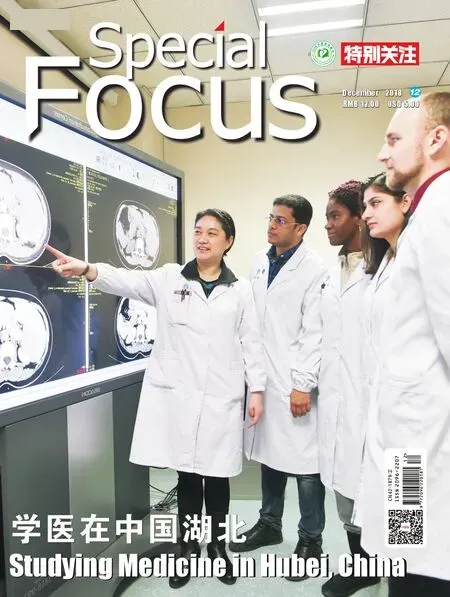“Hanhai-1” Debuts a“Thousand-container Era” in China's Inland River Shipping
Text by Ning Fang, Ma Liling & Meng Qi
Photos by Su Zhuolin
It was a sunny winter day on December 13, 2018.At 3:30 pm, we drove into Wuhan Yangluo Port Terminal where Hanhai-1, the largest ship in the upper and middle reaches of the Yangtze River, was berthed.
On seeing us, Duan Xinming,the captain, walked towards us from his working area, the crane frame. He wore a bright smile and walked with vigorous steps and powerful hands—this satisfaction and vigor illustrated to us the success of his working experience on the Yangtze River over the last 30 years.
“Big Mac” Carries a Thousand Containers a Time
What a thrilling experience it was to experience such scale! As the captain walked us to the dock area, a gigantic object gradually lifted its magic veil in front of us.The hull is so large we couldn't take in the whole ship in our field of view. We could only scan across it from the far stern.
The crane never stopped working, and proceeded to lift the containers, one after another, into a row of shore-line transporters.These containers were loaded with cargo from all over the world.“Hanhai-1” shipped them from Yangshan Port in Shanghai to Wuhan Port.
Along the steep gangway of the wharf, we all stepped down to a platform and then down to the ship using a bamboo ladder. The captain moved at a brisk pace, as if walking on the flat ground. We were frightened, for the bamboo ladder was only 30 centimeters wide, free from handrails,bouncing to and fro. What startled us most was that it was more than 10 meters above the turbid river.
Rarely do we consider that in a technology-dominant society,such a simple traditional climbing tool still could play an important role in the modern shipping industry.
The captain led us to the cockpit on the fourth floor. This spacious room was larger than the living room of a large villa,where various instruments were arranged in arcs. There were balancing plates, horizontal rulers, position indicators, and other instruments on the wall,along with a variety of signal flags,as well as Chinese and English contact tips. The cockpit was so well-lit and bright that the first mate could see all the gauges easily from the same spot.
Like heavy trucks, the cockpit functions as the bow and the fully loaded cabin functions as the hull. Ships are towed rather than carried out on the river.
Chief Mate Chen Hongbing,Chief Engineer Hu Wenhua,and Company Instructor Tang Pengcheng are all senior staff members who have certification as first-class captains and chief engineers. Speaking of the size of Hanhai-1, they introduced all kinds of data and information about the ship. “Before this ship,the largest one on the river could only hold about 600 containers,”the captain said. “This one is one compartment longer and one container wider.”
“It can load 1086 containers at a time, equivalent to 11 freight trains with 50 train cars at a time.And if it runs twenty times, the containers it carries can fill up one of the world's largest oceangoing container vessels. Thus, it is said that our ship has initiated a ‘Thousand-container Era' of inland river shipping on the Yangtze River,” the captain added,“The deck of our ship is as large as 7.5 standard basketball courts.”
“When the ship is empty, its highest point is more than 29 meters above the river, with a full load of more than 13,000 tons and a sink of about 6.6 meters,” added the chief mate, “At present, some bridges on the Yangtze River have restrained further development of the shipping industry. The distance between the bridge and the water surface is so limited that it hinders the building of big ships on the river.”
Reliable Performance Supported by Advanced Technologies
“Despite its large hull, it is much safer to operate than a smaller ship because of its reliable performance,” the captain said proudly. “The ship is 130 meters long and 23.9 meters wide. Due to the use of Guangchai power,double-drive and double-rudders,with more than 3,600 horsepower and more than 17,000 tons of cargo on board, it can be turned in situ within 200 meters.”
The captain further explained the specs. It can reach a speed of 11 knots when the ship is fully loaded. Such a speed has helped“Hanhai-1” earn the title of “highspeed train on water.” Because of its fast speed and quick rivercrossing abilities, it does not dominate waterway navigation and saves wharf locations. Before Hanhai-1 came into existence, it usually took two ships to carry the same amount of containers,and two and a half hours to shift and unload each boat at the port. In combination with the construction of Yangluo Port, the No. 1 quayside bridge with the capacity of lifting eight rows of containers, there has been increased efficiency in the capacity for loading containers from 28-30 natural containers to 31.5 per hour, thus saving space and time and greatly improving productivity.
Meanwhile, “Hanhai-1” has attached many conveniences to the crew's daily life. “It used to be the most difficult and dirty job to operate a turbine. Hour after hour of roaring noises can make one suffer from insomnia and nausea. Now that the engine is less noisy and fully automated,it is quite easy to operate just by sitting in the monitoring room,”the chief engineer beamed.“Now the ship is larger, but is managed by same amount of crew members. There are 11 crews on the whole ship, with three shifts of drivers and engineers, and even the bedrooms are bigger than before.” In the past, it took more than half a month to go back and forth to Shanghai by a smaller ship, but now it's done in eightdays. In addition, when loading and unloading cargo, the crew can take turns to reunite with their families, thus increasing their state of wellbeing.
The chief engineer introduced that “Hanhai-1” is an environmentally-friendly vessel. Because of its advanced equipment and lower noise, it minimizes harm to the fish in the river, and sometimes porpoises can be seen swimming not far from the ship. Moreover, the airtight design of the turbine is better, and the combustion is very efficient, which can reduce oil leakages and waste emissions.Furthermore, owing to the good economical benefits of larger ships, the smaller ships will gradually be eliminated, thereby reducing pollution on the river.
River-Sea Linkage Ignites the Development of Relevant Regions
It is reported that large enterprises such as Wuhan New Port, COSCO Shipping,China Changjiang National Shipping Group, Zhonggu Shipping and WUT SHIP have signed agreements to build five ships of this kind in Wuhu Port, Anhui Province—forming a transportation fleet from Wuhan to Shanghai,building a comprehensive threedimensional transportation corridor in Central China,and promoting the overall development of the Yangtze River Economic Belt.
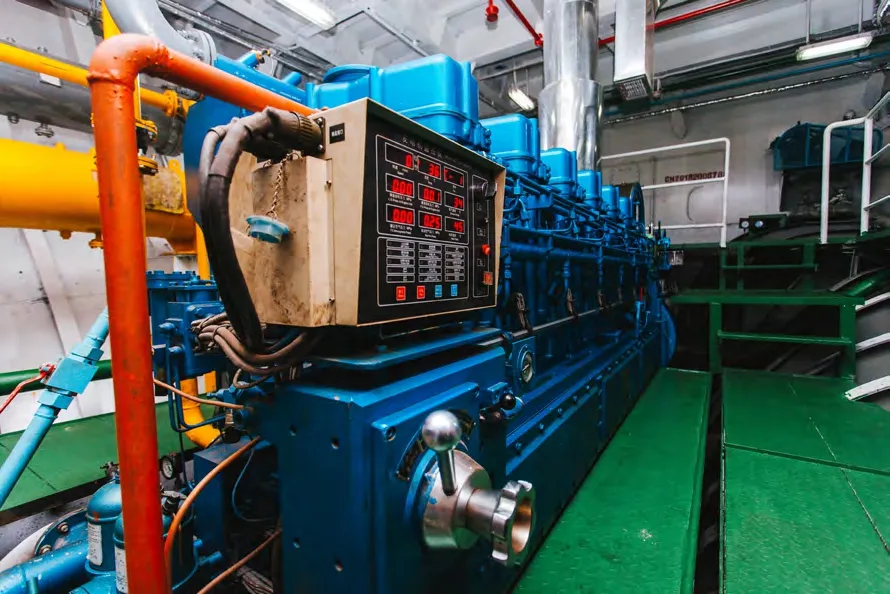
The debut of a “Thousandcontainer Era” not only marks an epoch-making moment for China's inland waterway shipping industry, but will also transform the model of transportation and river-sea intermodal transportation in Central China,thus making Wuhan an important supporting hub of “all upstream transit and full downstream diversion.” Wuhan New Port will further facilitate Yangluo Port's water and rail transit network and increase its service to provinces such as Sichuan, Chongqing,Hubei, Hunan, Guizhou, and Yunnan, as well as cities in the upper and middle reaches of the Yangtze River. It will also promote trade between these provinces and other countries in East Asia, Northeast Asia, the Pacific, and America.
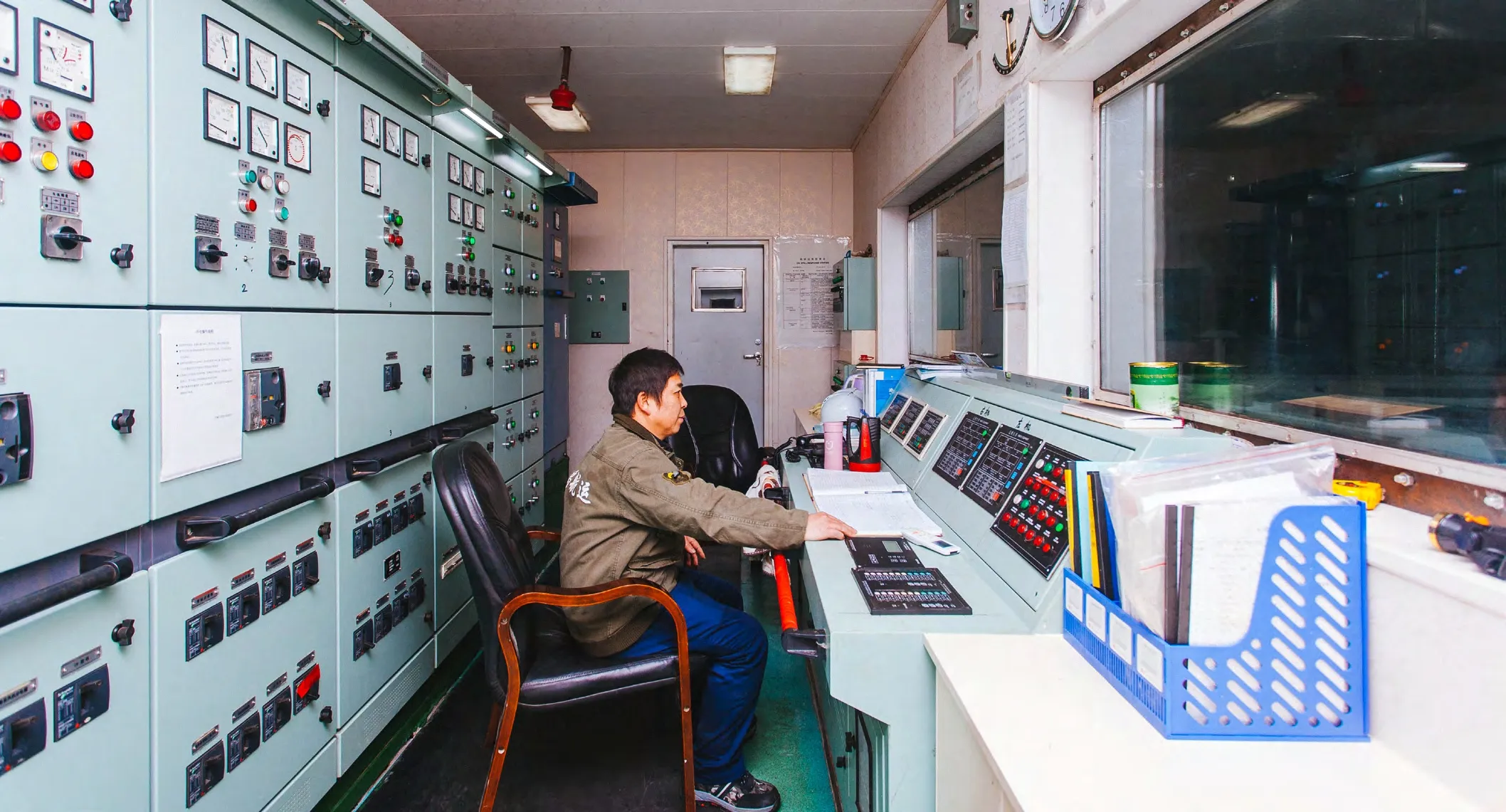
胡文华在轮机监控室Chief Engineer Hu Wenhua in the engine control room
It is reported that Wuhan New Port Management Committee will further develop the “Wuhan-Asia” ships sailing from Wuhan to Korea and Japan on the basis of the riversea direct ship type and initiate an era of international riversea intermodal transportation in Wuhan, meaning Wuhan will become a “seaport” for the central and western parts of China. At present, the 6-meter deep waterway regulation project of the Wuhan-Anqing section(abbreviated to the “Wu-An section”) of the Yangtze River,with a total investment of 3.7 billion yuan, has been fully launched. After the completion of the project, the minimum maintenance water depth of the 386.5-kilometer stretch in the Wu-An section will be increased from 4.5 meters to 6 meters. This will allow 13,000 tons of inland river vessels and 10,000-ton-level river-sea vessels to reach Wuhan all year round, even in the dry season, which will greatly increase shipping capacity.
In excavating the Yangtze River, many measures have been taken to promote ecological health in the Yangtze River.These measures include aquatic biological proliferation and drainage, ecological wetland construction, and fish nest bricks and rows.
Captain Duan Xinming stressed that doing things well depends greatly on talent. At present, nearly one million Chinese sailors are engaged in water transportation, while few brilliant crew members have united together for decades as they did in forming an “iron triangle” working team. With the continuous improvement and upgrade of water transportation equipment, China hungers for more first-class captains, first mates, and chief engineers who can navigate rivers and seas and promote the cooperation and mutual development of the“Maritime Silk Road” between China and other countries of the world.
(Translation: Qing Run)
“汉海1号”开启内河“千箱时代”
文 /宁 芳 马立玲 孟 齐 摄影 /苏卓琳
2018年12月13日,一个难得的温暖冬日。下午3点半,我们采访小组驾车驶进了武汉阳逻港码头,长江中上游新近首航的最大江轮“汉海1号”停泊在这里。
船长段新明从正在工作的起重机架下走向我们,笑容可掬,步伐健朗,刚劲有力的双手记录着长江上30多年的航程与沧桑。
“巨无霸”,一趟千箱
登船体验有点出乎预料。船长带着我们移步到码头边,一个庞然大物渐渐揭开面纱,船身大到我们无法将它尽收眼底,只能让目光从远处的船尾扫视过来。
起重机并没有停下,继续把一个船舱里码放整齐的集装箱一个一个地提起,挪到岸上一溜排开的转运卡车上。这些集装箱装载着来自世界各地的货物,“汉海1号”把它们从上海的洋山港运到这里。
我们沿着码头陡峭的舷梯下到一处平台,再通过一个普通的竹梯下到船上。船长轻快利索,如履平地,我们却着实心惊胆战了一回。竹梯只有大约30厘米宽,没有扶手,一步一弹,更令人惊悚的是下离江面还有10多米高,浑浊的江水轻微地晃动着。
没想到,科学高速发展的今天,传统的登高工具还发挥着如此重要的作用。
船长带着我们沿着舷梯,一直爬到位于第四层的驾驶舱。这个宽大的空间比一般别墅的会客厅还大,各种仪表呈弧形摆开,壁上挂着平衡盘、水平尺、定位仪等各种仪器,还放着各种信号旗,以及中英文联络提示语等。驾驶舱通透明亮,大副的视野可以达到240度。跟重卡一样,驾驶舱是船头,满载的船舱则是船身。轮船在江上是拖行而非推行。
大副陈红兵、轮机长胡文华和公司指导唐鹏程等都是持有一级船长、轮机长资格证的资深人士。说起“汉海1号”之大,他们纷纷介绍起船的各种数据。“在这艘船之前,前面那条船是江上最大的,它能装600多箱。”船长指着江面说,“我们这艘比它长一个舱位,宽一个箱位。”
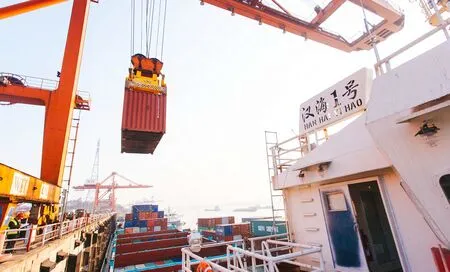
汉海1号在武汉阳逻港卸货A container being lifted up from Hanhai-1 at Wuhan Yangluo Port
“我们一次可以装1086箱,一次运量相当于11列50节车厢的货运列车,跑二十次的运量就可以装满一艘世界最大的集装箱远洋货轮,所以说,我们这艘船开启了长江内河航运的‘千箱时代’。”轮机长补充道,“这艘船的舺板面积有7.5个标准篮球场那么大。”
“空船时,船最高点离江面29米多,满载可达13000多吨,吃水6.6米左右。”大副接过话头,“目前,长江上有些桥梁已经成了影响航运的因素,桥身与水面距离太短,影响江轮进一步往高大方向发展。”
性能全,科技护航
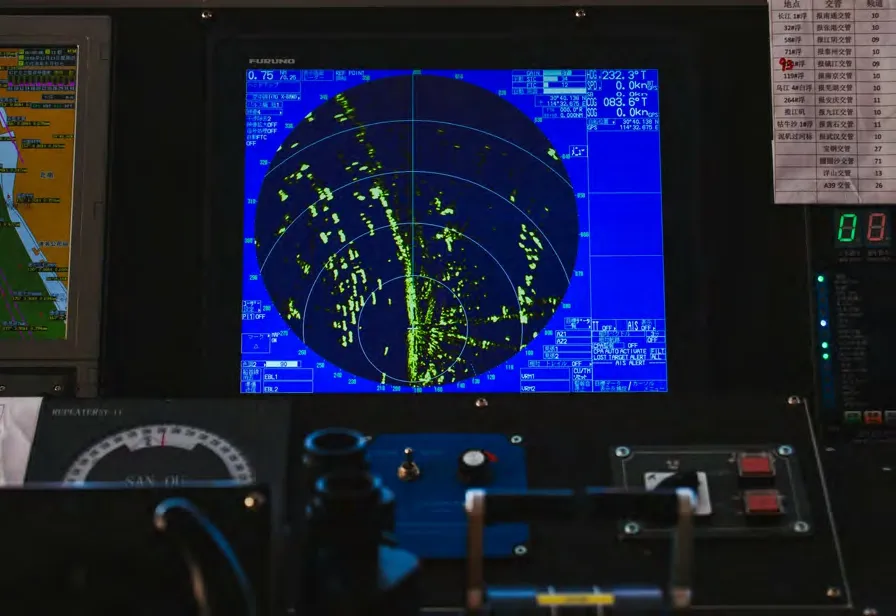
汉海1号设备先进Advanced equipment in the cockpit of Hanhai-1
“别看这艘船体大身重,由于性能好,操作起来比小船还稳当。”船长列出几项参数,“这艘船长130米,宽23.9米,由于采用广柴动力,双驱双舵,3600多马力,连船带货17000多吨,可以在200米范围内原地调头。”
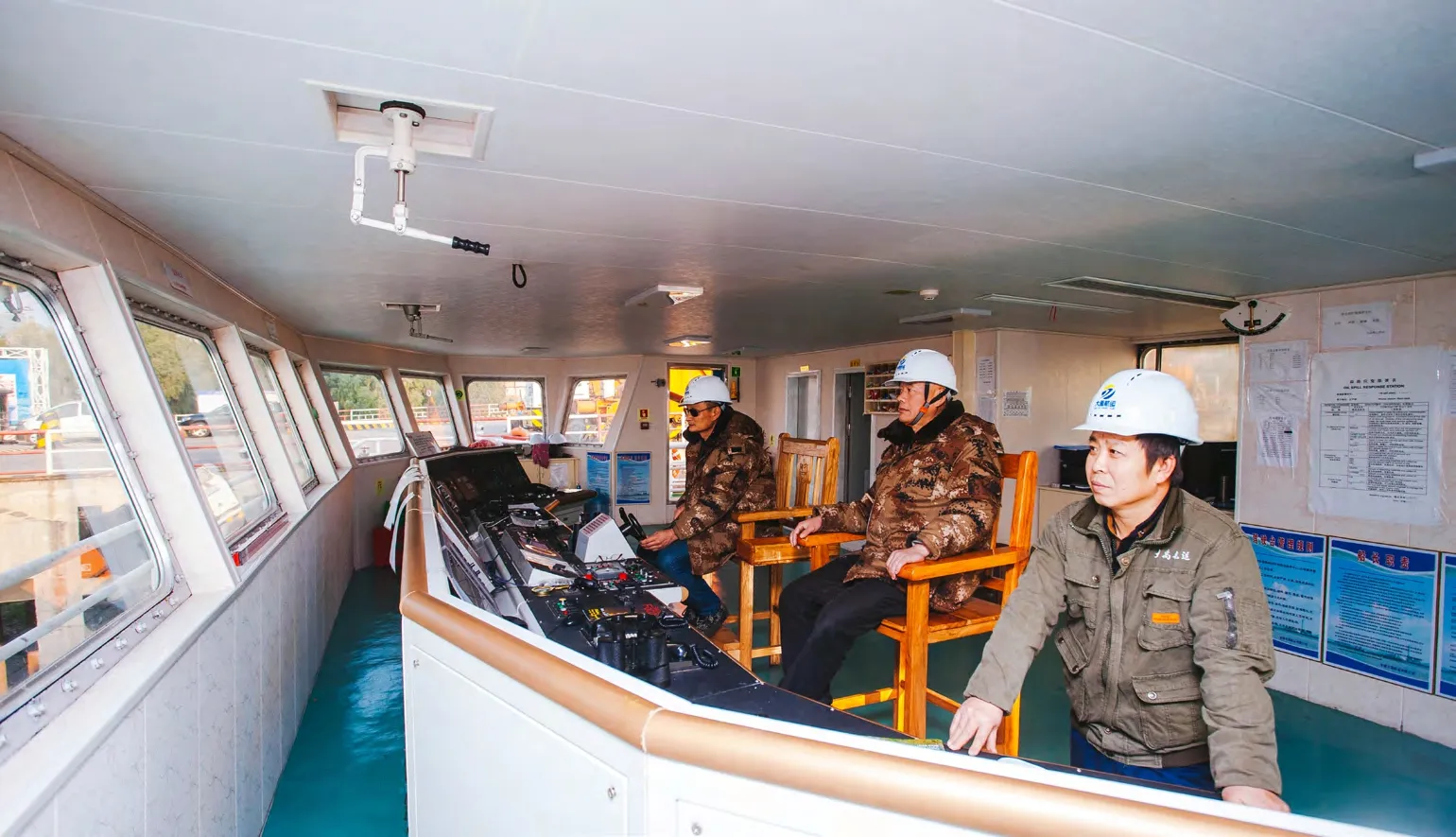
大副陈红兵(左)、船长段新明(中)和轮机长胡文华(右)在驾驶舱Chief Mate Chen Hongbing (left), Captain Duan Xinming (middle), and Chief Engineer Hu Wenhua (right) in the cockpit
据船长介绍,这艘船满载时,航速可达11节。这样的速度使得“汉海1号”有了“水上高铁”的称号。由于它速度快,通过江面也很快,所以不占航道。“汉海1号”还省码头。同样数量的集装箱,以前需要两艘船运载,两船进出港换档卸货需要2个半小时。阳逻港建造之初,就超前设计的具有吊装八排集装箱能力的1号岸桥,终于可以派上用场,使重箱装船效率从28~30自然箱/小时提升到31.5自然箱/小时,节省了空间、时间,效率大为改善。
“汉海1号”为船员们的生活带来了很多便利。“以前操控轮机是天底下最吃亏的事情,几个小时轮机轰鸣声能让你难受到失眠、恶心,现在轮机不仅噪音小了,还全部自动化,操作轮机只需坐在监控室里观察调控就轻松搞定。”这是轮机长最切身的感受。“船大了,船员还是那么多。全船11个人,驾驶、轮机三班倒,连睡觉的房间都大些。”以前开小船,武汉到上海一个来回要半个多月,现在8天搞定,而且装卸货物时,船员们还可以轮流与家人团聚,幸福指数提高了。
轮机长介绍,“汉海1号”还创造了很高的环保价值。由于设备先进,噪音小,减少了对水中鱼类的影响,有时在离船不远的地方还会看到江豚。而且,轮机的密封性能比较好,燃烧非常充分,可以减少油漏和废气排放。再者,由于大船效益好,小船会逐渐被淘汰,从而减少江上船只的污染排放量。
江海通,区域拉动
据报道,武汉新港、中远海运、长航集团、中谷海运、武汉理工船舶等大型企业已经签订协议,将在安徽芜湖等港继续建造5艘这样的大船,形成武汉到上海江海直达运输船队,构建华中综合立体交通走廊,推动长江经济带发展。
“千箱时代”的开启,不仅对中国内河航运有着划时代的意义,更将改变华中地区交通运输和江海联运格局,使武汉成为“上游全中转、下游全分流”的重要支撑节点。武汉新港将进一步完善阳逻港水运、水铁联运中转网络,加大对长江中上游川、渝、鄂、湘、贵、滇等省市的服务能力,为这些省份与东亚、东北亚、太平洋和美洲诸国的贸易往来提供便利。
此外,武汉新港管委会还将在江海直达船型的基础上,进一步研发武汉至韩国和日本的“汉亚型”船,开辟武汉国际江海联运时代,使武汉真正成为中国中西部“海港”。目前,总投资37亿元的长江武汉至安庆段(简称武安段)6米水深航道整治工程全面启动。工程建成后,武安段386.5公里的航道最低维护水深将由现在的4.5米加深至6米,可实现13000吨内河船舶、万吨级江海船舶常年直达武汉,不受枯水季节限制,大大提升航运能力。
在江深整治的同时,工程将采取水生生物增殖放流、疏浚土营造生态湿地、使用鱼巢砖和鱼巢排等生态结构等多种措施,促进长江生态大保护。
凡事要靠人,段新明说,目前,中国从事水运事业的大军近百万,而像他们这样的核心船员几十年紧紧抱在一起、组成“铁三角”的并不多。在水上运输设备不断改进升级的同时,中国需要更多一等一的船长、大副、轮机长去搏击江海,推动中国与世界其他国家“海上丝绸之路”的不断延伸和融合发展。

